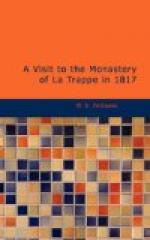As we were about to quit the place some time after, we were arrested by two gendarmes, and it was not till after a detention of some hours, and a long discussion between the police officers who had been summoned to attend, and being threatened to be sent to the Conciergerie prison, that we were allowed to depart.
The following words were engraved on a plain marble slab that covered the remains of Marshal Ney.
CI GIT
LE MARECHAL NEY
DUC D’ECHLINGEN
PRINCE DE MOSCOWA
DECEDE le 7, Decembre, 1815.
The grave of the Marshal, as well as that of Labedoyere, when I again visited the spot, had been stripped of every thing, and the railing around them removed so as to prevent any one from discovering the place of their interment.
The monument of Madame Cottin, the author of Elizabeth and of Mathilde, is, like her writings, simple and affecting!-Surrounded by a trellis work in the form of an arbour, planted with rose trees, stands a pillar of the whitest marble, highly polished, inclining forwards, and engraved with:
ICI REPOSE Marie-Sophie Risteav Veuve de J.M. Cottin Decedee le 25 Aout. 1815.
Near this is the tomb of the esteemed and celebrated poet Delille, the “Songster of the Gardens,” as the French term him. The monument is enclosed in a small garden, planted with the choicest flowers and shrubs: it is of white marble, of large dimensions, and approached by an allee verte. The door leading to the vault is of brass, with emblematical figures in relief: above the entrance is inscribed in letters of gold.
JACQVES-DELILLE.
The linden tree, intermixed with various evergreens, form an interesting and beautiful bouquet around it.
Beyond this, to the right, are the tombs of Gretry the composer, Fourcroy the great chemist, Fontenelle, Boileau, Racine, and of Mademoiselle Raucourt, the celebrated actress, to whom the bigotry of the clergy refused burial in consecrated ground in 1815! a circumstance which gave rise to much clamour and dissatisfaction. It is surprising, that after such events as have been experienced in France, the folly of denying the right of consecrated ground to a comedian should have been persevered in, after the restoration of Louis XVIII!
Close to the tomb of Mad’lle Raucourt, is one, which for its affecting simplicity and modesty, struck me very forcibly: in a little garden of roses and lilies, and amidst some tufts of mignonette which appeared to have been newly watered, stood a plain marble column, with the words as represented in the annexed sketch—an accacia shaded it from the sun’s rays. In 1814, when the Allies approached Paris, this height, like the others commanding the capital, was fortified, and occupied by the students of the Polytechnical School, who defended it with great gallantry. The walls were perforated with holes for the musketry: the marks are still visible where they have been since filled up. On the 30th of March, 1814, this position was vigorously attacked, with great slaughter on both sides: the assailants and the assailed fell in heaps, and it was not until the chief part of a Prussian corps, (that afterwards carried it by assault) had been annihilated, that the brave youths gave way.




